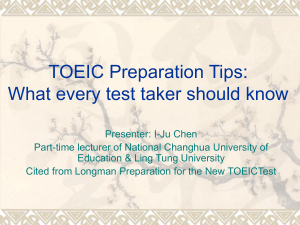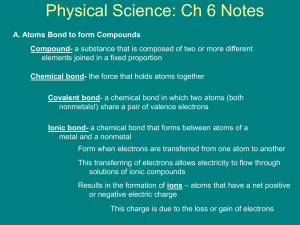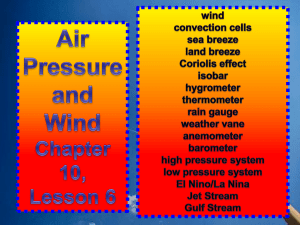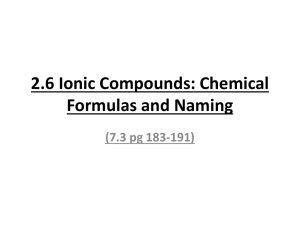Lecture 4
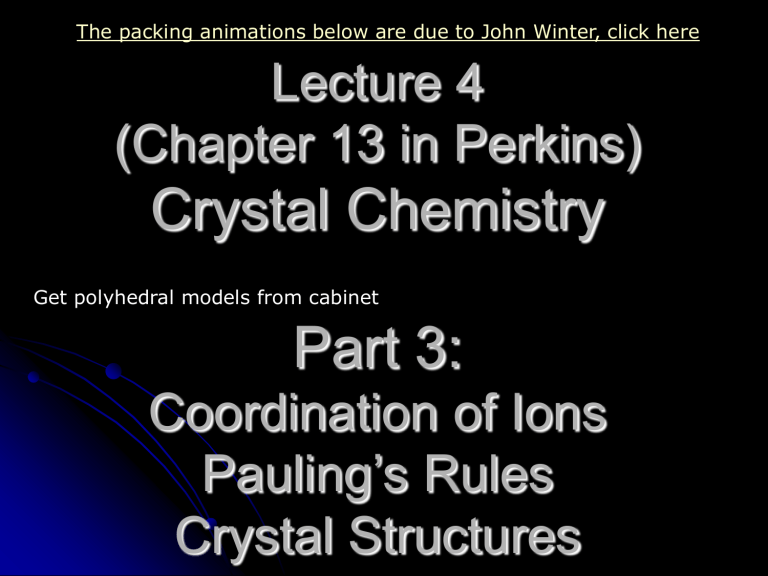
The packing animations below are due to John Winter, click here
Lecture 4
(Chapter 13 in Perkins)
Crystal Chemistry
Get polyhedral models from cabinet
Part 3:
Coordination of Ions
Pauling’s Rules
Crystal Structures
Coordination of Ions
For ionic bonding, ion geometry ~ spherical
Spherical ions will geometrically pack
( coordinate ) oppositely charged ions around them as tightly as possible while maintaining charge neutrality
For a particular ion, the surrounding coordination ions define the apices (corners) of a polyhedron
The number of surrounding ions is the
Coordination Number
•
•
Ionic Compound Formation
Anions
– negatively charged
– Larger than the un-ionized atom
Cations
– positively charged
• Smaller than the un-ionized atom
-
• Attraction
» Anion – Cation
+
• Repulsion
» Anion – Anion
» Cation – Cation
-
+ +
Coordination
Number and
Radius Ratio
Radius Ratio is
Rc (cation) / Ra (anion)
See Figure 13.3 of Perkins
See also the Ionic
Radii table of Perkins, following the inside front cover
Atomic and Ionic Radii
Can't absolutely determine: e cloud is nebulous & based on probability of encountering an e .
In crystalline solids the center-to-center distance = bond length & is accepted to = sum of ionic radii
How get ionic radius of X & Y in XY compound??
Atomic and Ionic Radii
Pure element first
Native Cu. Atomic radius = 1/2 bond length a a
X-ray d
100
a
Ionic radius =
2 a
2
4
Atomic Radii
Absolute radius of an atom based on location of the maximum density of outermost electron shell
Effective radius dependent on the charge, type, size, and number of neighboring atoms/ions
- in bonds between identical atoms, this is half the interatomic distance
- in bonds between different ions, the distance between the ions is controlled by the attractive and repulsive force between the two ions and their charges
Charge and Attractive Force Control on Effective Ionic Radii
Approach until Repulsive and Attractive
Forces the same
Effect of Coordination Number and Valence on
Effective Ionic Radius
Higher coordination numbers have larger effective ionic radius
Extreme valence shells (1,6,7) have larger effective ionic radius
Decreasing
Ionic radii
Coordination
Number (CN)
(# of nearest neighbors) vs. ionic radius.
For cations of one element, higher coordination numbers have larger effective ionic radius
Coordination with O
-2
Anions
Note: Sulfur can have CN 6 at great depths
For example, in the inner core
When Rc / Ra approaches 1
a “c lose packed” array forms
Coordination Polyhedra
We always consider coordination of anions about a central cation
Halite
Na
Cl
Cl Cl
Cl
Coordination Polyhedra
Can predict the coordination by considering the radius ratio:
R
C
/R
A
Cations are generally smaller than anions so begin with maximum ratio = 1.0
Coordination Polyhedra
Radius Ratio: R
C
/R
A
= 1.0
(commonly native elements)
Equal sized spheres
“Closest Packed”
Notice:6 nearest neighbors in the plane arranged in a hexagon
Note dimples in which next layer atoms will settle
Two dimple types:
Type 1 upper point NE
Type 2 upper point NW
They are equivalent since you could rotate the whole structure 60 o and exchange them
2 1
Closest Packing
Add next layer
(red)
Once first red atom settles in, can only fill other dimples of that type
In this case covered all type 2 dimples, only 1’s are left
1
Closest Packing
Third layer ?
Third layer dimples again 2 types
Call layer 1 A sites
Layer 2 = B sites ( no matter which choice of dimples is occupied )
Layer 3 can now occupy A-type site (directly above yellow atoms) or C-type site (above voids in both A and B layers)
A C
Closest Packing
Third layer:
If occupy A-type site the layer ordering becomes A-B-A-B and creates a hexagonal closest packed structure
(HCP)
Coordination number (nearest or touching neighbors) = 12
6 coplanar
3 above the plane
3 below the plane
Closest Packing
Third layer:
If occupy A-type site the layer ordering becomes A-B-A-B and creates a hexagonal closest packed structure
(HCP)
Closest Packing
Third layer:
If occupy A-type site the layer ordering becomes A-B-A-B and creates a hexagonal closest packed structure
(HCP)
Closest Packing
Third layer:
If occupy A-type site the layer ordering becomes A-B-A-B and creates a hexagonal closest packed structure
(HCP)
Closest Packing
Third layer:
If occupy A-type site the layer ordering becomes A-B-A-B and creates a hexagonal closest packed structure
(HCP)
Note top layer atoms are directly above bottom layer atoms
Third layer:
Unit cell
Closest Packing
Third layer:
Unit cell
Closest Packing
Third layer:
Unit cell
Closest Packing
Closest Packing
Third layer:
View from top shows hexagonal unit cell
(HCP)
Closest Packing
Third layer:
View from top shows hexagonal unit cell
(HCP)
Closest Packing
Alternatively we could place the third layer in the C-type site (above voids in both A and B layers)
C
Closest Packing
Third layer:
If occupy C-type site the layer ordering is A-B-C-A-B-C and creates a cubic closest packed structure
(CCP)
Blue layer atoms are now in a unique position above voids between atoms in layers A and B
Closest Packing
Third layer:
If occupy C-type site the layer ordering is A-B-C-A-B-C and creates a cubic closest packed structure
(CCP)
Blue layer atoms are now in a unique position above voids between atoms in layers A and B
Closest Packing
Third layer:
If occupy C-type site the layer ordering is A-B-C-A-B-C and creates a cubic closest packed structure
(CCP)
Blue layer atoms are now in a unique position above voids between atoms in layers A and B
Closest Packing
Third layer:
If occupy C-type site the layer ordering is A-B-C-A-B-C and creates a cubic closest packed structure
(CCP)
Blue layer atoms are now in a unique position above voids between atoms in layers A and B
Closest Packing
Third layer:
If occupy C-type site the layer ordering is A-B-C-A-B-C and creates a cubic closest packed structure
(CCP)
Blue layer atoms are now in a unique position above voids between atoms in layers A and B
Cubic Closest Packing
View from the same side shows the cubic close packing
(CCP), also called face-centered cubic
(FCC) because of the unit cell that results. Notice that every face of the cube has an atom at every face center.
C-layer
A-layer
The atoms are slightly shrunken to aid in visualizing the structure
B-layer
A-layer
Closest Packing
Rotating toward a top view
Closest Packing
Rotating toward a top view
Closest Packing
You are looking at a top yellow layer A with a blue layer C below, then a red layer B and a yellow layer A again at the bottom
What happens when R
C
/R
A decreases?
The center cation becomes too small for the
C.N.=12 site (as if a hard-sphere atom model began to rattle in the 12 site) and it drops to the next lower coordination number (next smaller site).
It will do this even if it is slightly too large for the next lower site.
It is as though it is better to fit a slightly large cation into a smaller site than to have one rattle about in a site that is too large.
The next smaller crystal site is the CUBE:
Body-Centered Cubic
(BCC) with cation
(red) in the center of a cube
Coordination number is now 8 (corners of cube)
A central cation will remain in 8 coordination with decreasing R
C
/R
A until it again reaches the limiting situation in which all atoms mutually touch.
Then a hard-sphere cation would “rattle” in the position, and it would shift to the next lower coordination (next smaller site).
Set = 1
What is the R
C
/R
A that limiting condition??
of arbitrary since will deal with ratios
Diagonal length then = 2
A central cation will remain in 8 coordination with decreasing R
C
/R
A until it again reaches the limiting situation in which all atoms mutually touch.
Then a hard-sphere cation would “rattle” in the position, and it would shift to the next lower coordination (next smaller site).
What is the R
C
/R
A that limiting of condition??
Rotate
A central cation will remain in 8 coordination with decreasing R
C
/R
A until it again reaches the limiting situation in which all atoms mutually touch.
Then a hard-sphere cation would “rattle” in the position, and it would shift to the next lower coordination (next smaller site).
What is the R
C
/R
A that limiting of condition??
Rotate
A central cation will remain in 8 coordination with decreasing R
C
/R
A until it again reaches the limiting situation in which all atoms mutually touch.
Then a hard-sphere cation would “rattle” in the position, and it would shift to the next lower coordination (next smaller site).
What is the R
C
/R
A that limiting of condition??
Rotate
A central cation will remain in 8 coordination with decreasing R
C
/R
A until it again reaches the limiting situation in which all atoms mutually touch.
Then a hard-sphere cation would “rattle” in the position, and it would shift to the next lower coordination (next smaller site).
What is the R
C
/R
A that limiting of condition??
Rotate
A central cation will remain in 8 coordination with decreasing R
C
/R
A until it again reaches the limiting situation in which all atoms mutually touch.
Then a hard-sphere cation would “rattle” in the position, and it would shift to the next lower coordination (next smaller site).
What is the R
C
/R
A that limiting of condition??
Rotate
A central cation will remain in 8 coordination with decreasing R
C
/R
A until it again reaches the limiting situation in which all atoms mutually touch.
Then a hard-sphere cation would “rattle” in the position, and it would shift to the next lower coordination (next smaller site).
What is the R
C
/R
A that limiting of condition??
Rotate
A central cation will remain in 8 coordination with decreasing R
C
/R
A until it again reaches the limiting situation in which all atoms mutually touch.
Then a hard-sphere cation would “rattle” in the position, and it would shift to the next lower coordination (next smaller site).
What is the R
C
/R
A that limiting of condition??
Rotate
A central cation will remain in 8 coordination with decreasing R
C
/R
A until it again reaches the limiting situation in which all atoms mutually touch.
Central Plane = 1 + 2 = 1.732
What is the R
C
/R
A that limiting of condition??
1.732 = d
C
+ d
A
If d
A
= 1 then d
C
= 0.732
d
C
/d
A
= R
C
/R
A
= 0.732/1 = 0.732
= 1
(arbitrary)
= 2
The limits for 8 coordination are thus between 1.0
(when it would be CCP or HCP) and 0.732
= 1 + 2 = 1.732
Note: Body Centered
Cubic is not a closest-packed oxygen arrangement.
= 1
(arbitrary)
= 2
As R
C
/R
A continues to decrease below the 0.732 the cation will move to the next lower coordination: 6, VI, or octahedral. The cation is in the center of an octahedron of closest-packed oxygen atoms
As R
C
/R
A continues to decrease below the 0.732 the cation will move to the next lower coordination: 6, VI, or octahedral. The cation is in the center of an octahedron of closest-packed oxygen atoms
As R
C
/R
A continues to decrease below the 0.732 the cation will move to the next lower coordination: 6, VI, or octahedral. The cation is in the center of an octahedron of closest-packed oxygen atoms
As R
C
/R
A continues to decrease below the 0.732 the cation will move to the next lower coordination: 6, VI, or octahedral. The cation is in the center of an octahedron of closest-packed oxygen atoms
As R
C
/R
A continues to decrease below the 0.732 the cation will move to the next lower coordination: 6, VI, or octahedral. The cation is in the center of an octahedron of closest-packed oxygen atoms
As R
C
/R
A continues to decrease below the 0.732 the cation will move to the next lower coordination: VI, or octahedral. The cation is in the center of an octahedron of closest-packed oxygen atoms
What is the R
C
/R
A that limiting condition??
of
= 2
= 1
1.414 = d
C
+ d
A
If d
A
= 1 then d
C
= 0.414
d
C
/d
A
= R
C
/R
A
= 0.414/1 = 0.414
As R
C
/R
A continues to decrease below the 0.414 the cation will move to the next lower coordination: 4, IV, or tetrahedral. The cation is in the center of an tetrahedron of closest-packed oxygen atoms
As R
C
/R
A continues to decrease below the 0.414 the cation will move to the next lower coordination: 4, IV, or tetrahedral. The cation is in the center of an tetrahedron of closest-packed oxygen atoms
As R
C
/R
A continues to decrease below the 0.414 the cation will move to the next lower coordination: 4, IV, or tetrahedral. The cation is in the center of an tetrahedron of closest-packed oxygen atoms
As R
C
/R
A continues to decrease below the 0.414 the cation will move to the next lower coordination: 4, IV, or tetrahedral. The cation is in the center of an tetrahedron of closest-packed oxygen atoms
As R
C
/R
A continues to decrease below the 0.414 the cation will move to the next lower coordination: 4, IV, or tetrahedral. The cation is in the center of an tetrahedron of closest-packed oxygen atoms
As R
C
/R
A continues to decrease below the 0.414 the cation will move to the next lower coordination: 4, IV, or tetrahedral. The cation is in the center of an tetrahedron of closest-packed oxygen atoms
As R
C
/R
A continues to decrease below the 0.414 the cation will move to the next lower coordination: 4, IV, or tetrahedral. The cation is in the center of an tetrahedron of closest-packed oxygen atoms
As R
C
/R
A continues to decrease below the 0.414 the cation will move to the next lower coordination: IV, or tetrahedral. The cation is in the center of an tetrahedron of closest-packed oxygen atoms
What is the R
C
/R
A of the limiting condition??
Center-to-corner distance of a tetrahedron with edges of
1.0 = 0.6124
See derivation fig 4.3 c page 70
R
C
= 0.6124 - 0.5 = 0.1124
R
C
/R
A
= 0.1124/0.5 = 0.225
1
0.5
0.61
As R
C
/R
A continues to decrease below the 0.22 the cation will move to the next lower coordination:
III. The cation moves from the center of the tetrahedron to the center of an coplanar tetrahedral face of 3 oxygen atoms
What is the R
C
/R
A of the limiting condition??
cos 60 = 0.5/y y = 0.5774
1
0.5
y
R
C
= 0.5774 - 0.5 = 0.0774
R
C
/R
A
= 0.0774/0.5 = 0.155
If R
C
/R
A decreases below 0.15 the cation will move to the next lower coordination: 2 or II. The cation moves directly between 2 neighboring oxygen atoms
Pauling’s Rules
Rule 1: A coordination polyhedron of anions is formed around each cation, where:
- the cation-anion distance is determined by the sum of the ionic radii, and
- the coordination number of the polyhedron is determined by the cation/anion radius ratio (Rc:Ra)
Linus Pauling
Pauling’s Rules
Rule 2: The electrostatic valency principle
The strength of an ionic (electrostatic) bond (electrostatic valency e.v.) between a cation and an anion is equal to the charge of the ion (z) divided by its coordination number (n): e.v. = z/n
In a stable (neutral) structure, a charge balance results between the cation and its polyhedral anions with which it is bonded.
Charge Balance in Halite
In Halite, Na + has CN 6 and valence +1
Interpretation: Each Na
+ has 6 Cl neighbors, so each Clcontributes a charge of -1/6 to the Na +
6 x -1/6 = -1, so a charge balance results between the
Na+ cation and the six polyhedral Cl- anions with which it bonded. NEUTRALITY IS ACHIEVED
Charge
Balance In
Fluorite
In Fluorite , Ca ++ has CN 8 and valence +2, so the electrostatic valency is
¼ e.v.
Interpretation: Each Ca ++ has 8 F neighbors, so each Fcontributes a charge of -1/4 to the Ca ++
8 x -1/4 = -2, so a charge balance results between the
Ca ++ cation and the eight polyhedral F- anions with which it bonded. NEUTRALITY IS ACHIEVED
If electronegativity of anion and cation differs by 2.0 or more will be ionic
Formation of Anionic Groups
C has valence +4
C.N = 3 e.v. = 4/3 = 1 1/3
S has valence +6
CN = 4 electrostatic valency = 6/4 = 1 1/2 e- for Carbon 2.5, for O 3.5 covalent e- S 2.4 so also covalent
Carbonate
Sulfate
Remaining charge on Oxygens available for bonding
Pauling’s Rules
Rule 3: Sharing of faces or edges is unstable.
Rule 4: In structures with different types of cations, those cations with high valency and small CN tend not to share polyhedra with each other; when they do, polyhedra are deformed to accommodate cation repulsion
C.N. = “coordination number”
Pauling’s Rules -
principle of parsimony
The number and types of different structural sites tends to be limited, even in complex minerals.
Comment: Different ionic elements are forced to occupy the same structural positions. This leads to solid solution.
Ionic Compound Formation
Stable ionic crystals:
maximize cation-anion contact
minimize anion-anion & cation-cation contact
2-dimensional illustration of the concept of stability:
Visualizing Crystal Structure
Beryl - Be
3
Al
2
(Si
6
O
18
) Gold colored spheres cations
Ball and Stick Model
Show polyhedral models
Polyhedra Model
4-O Tetrahedral (T) and 6-O Octahedral (O)
Isostructural Types
AX Compounds – Halite (NaCl) structure
Anions – in Cubic Close Packing
Cations – in octahedral sites
Rc/Ra =.73-.41 so CN = 6
Examples:
Halides: +1 cations (Li, Na, K, Rb) w/ anion charge -1: anions (F, Cl, Br, I)
Oxides: +2 cations (Mg, Ca, Sr, Ba, Ni) w/ O -2
Sulfides: +2 cations (Zn, Pb) w/ S -2
Isostructural Types
CCP= FCC close packing of the anions, small cations in octohedral “holes”
Isostructural Types
AX Compounds – Sphalerite (ZnS) structure
R
Zn
/R
S
=0.60/1.84=0.32 (tetrahedral)
Isostructural Types
AX
2
Compounds – Fluorite (CaF
2
) structure
Example CaF
2
:
R
Ca
/ R
F
= 1.12 / 1.31 = 0.75 (cubic CN = 8)
Examples: some Halides (CaF
2
, BaCl
2
...); Oxides (ZrO
2
...)
Isostructural Types – O and T sites
-
-
ABO
4
Compounds – Spinel (MgAl
2
O
4
)structure
Oxygen anions in CCP array
Two different cations (may be same element w two different valences) in tetrahedral (T) sites (e.g. Mg 2+ , Fe 2+ , Mn 2+ , Zn 2+ ) or octahedral (O) sites (e.g. Al 3+ , Cr 3+ , Fe 3+ )
Nesosilicates
Olivine, Zircon
Staurolite
Sorosilicates
Epidote
Cyclosilicates
Beryl
Tourmaline
Inosilicates
(single chain)
Pyroxenes
Inosilicates
(double chain)
Amphiboles
Phyllosilicates
Micas, clays
Serpentine
Chlorite
Tectosilicates
Quartz group,
Feldspars
Feldspathoids
Zeolites
Next time
Crystal Chemistry IV
Compositional Variation of Minerals
Solid Solution
Mineral Formula Calculations
Graphical Representation of Mineral
Compositions






